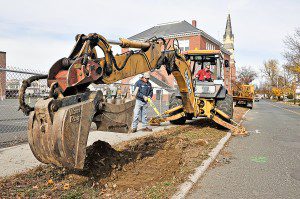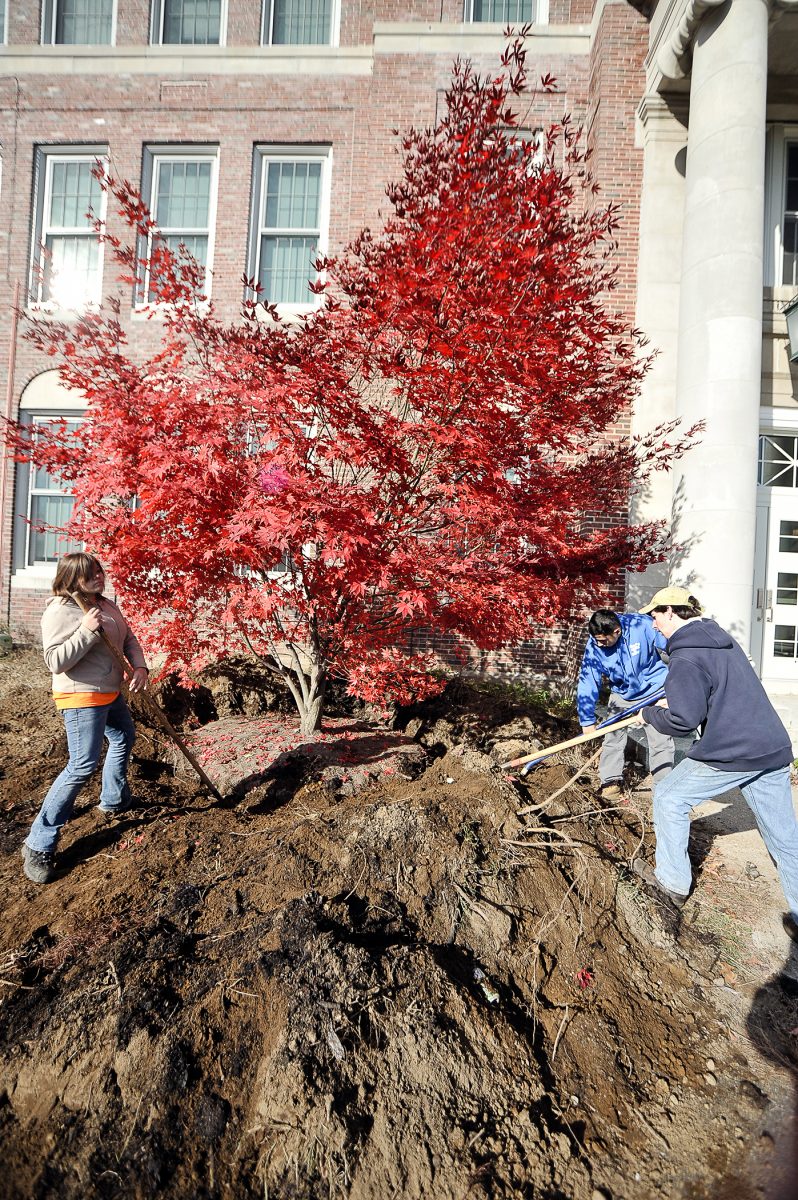
Joel Faira, a heavy equipment operator for the Westfield Department of Public Works, uses a backhoe to dig a hole on Mechanic Street where a tree will be planted as part of the Tree City USA program sponsored by the Arbor Day Foundation which recognize cities for their excellence in urban forestry management. Due to it’s close proximity to a gas line much of the work had to be done by hand. (Photo by Frederick Gore)
WESTFIELD – Plans to replant three trees in one of the city’s most densely populated neighborhoods hit a temporary snag yesterday, as workers from the city’s Department of Public Works debated whether or not to plant several saplings on Mechanic Street just above a municipally-owned gas line.
In the end, city laborers were given the go-ahead from City Hall to proceed with caution and plant three European Hornbeams along the sidewalk bordering the property of St. Mary’s School, digging as close to the concrete as possible to avoid placing the trees directly over the PVC gas line.

The Westfield Department of Public Works replanted three trees along Mechanic Street near the Saint Mary Parish Schools as part of the Tree City USA program sponsored by the Arbor Day Foundation which recognize cities for their excellence in urban forestry management. (Photo by Frederick Gore)
“The root balls (of the trees) are about two feet wide, so we dug down one foot until they hit the ribbon,” said one of the DPW workers, who then added that the piping is usually placed a foot below the ribbon.
Casey Berube of the DPW stated that the Hornbeams were replacing trees that had once lined the street as part of the city’s effort to earn the distinction of “Tree City USA.”
“There used to be Oak’s here, but the Mayor (Daniel M. Knapik) wanted to replace them,” said Berube.
Workers first dug the hole with a small excavator, only to fill the hole and start over with shovels soon after in an effort to get closer to the sidewalk, which Berube said would change the trajectory of the tree’s growth.
While he admitted there was the potential for the tree to cut into the sidewalk, Berube alluded that it would be far more favorable to replace a chunk of and/or cut the sidewalk back than to plant the tree directly over the gas line.
“You could replace it with concrete, but the cheapest way would be to do asphalt,” he said, looking on from across the street. “But I’m not sure it’ll destroy the sidewalk.”
City Engineer Mark Cresotti said that he gave the word on the placement of the trees closer to the sidewalk.
“My direction to DPW was to put them over on the edge of the sidewalk, to narrow it (the sidewalk) and cut it back slightly to give the trees some room,” he said.
“Utilities in the vicinity – underground or above ground – you have a lot of development, so it’s difficult,” he said. “But it’s definitely desirable. Studies have shown that the presence of an ‘urban forest’ has an effect on socioeconomics.”
“The more trees, the higher the socioeconomic strata,” Cresotti said.
Cressotti said that flowering trees have been planted under power lines throughout the city. Asked of how the gas line’s presence near the roots would affect the growth of the three trees, Cresotti said it shouldn’t have an effect.
“The gas lines don’t leak like they did in the past,” he said. “The trees aren’t attracted to the gas line.”
Diana McLean, Community Development Block Grant (CDBG) coordinator for the city of Westfield, said that the city has already been given the Tree City USA distinction but must earn the designation every year by planting more trees.
“We have to have photos published. We meet a dollar requirement by counting the salaries of DPW treeworkers, involvement with different groups and filling out paperwork,” she said of the criteria for being renamed a Tree City.
On the value of a municipality having arboreal development, McLean echoed Cresotti’s sentiments about the value of trees.
“If you’re a walking community, you like for people to be comfortable outside. You like to have places for birds to nest,” she said. “We focus on ‘work, live and play’ and that’s part of the ‘live’ component. We want to have aesthetically pleasing neighborhoods, in addition to having a healthy environment.”


